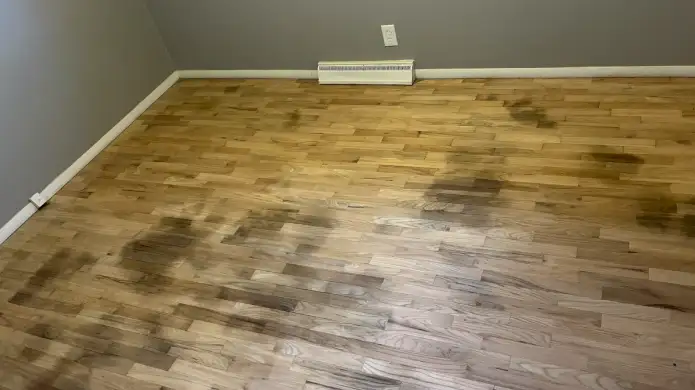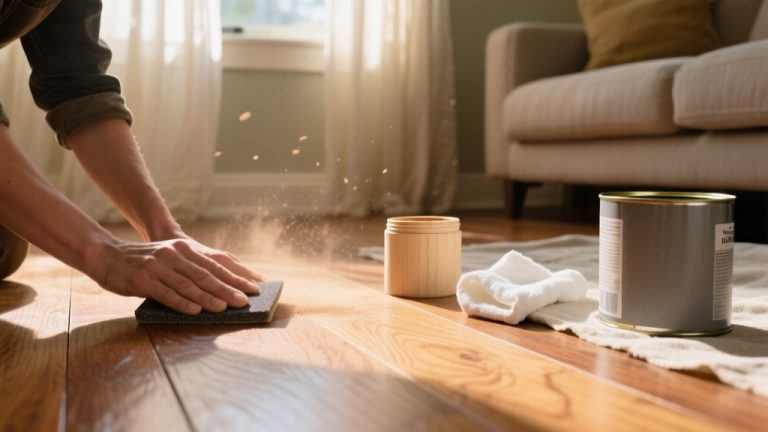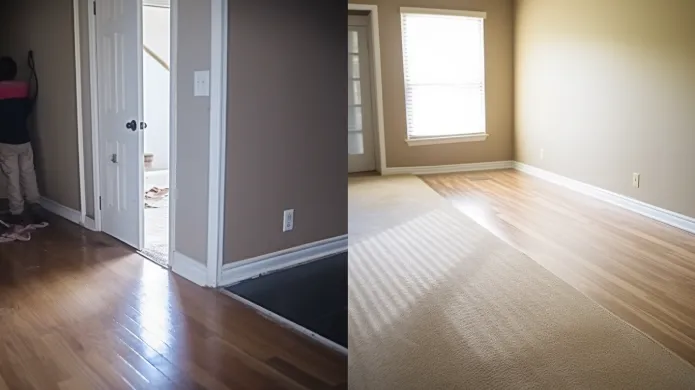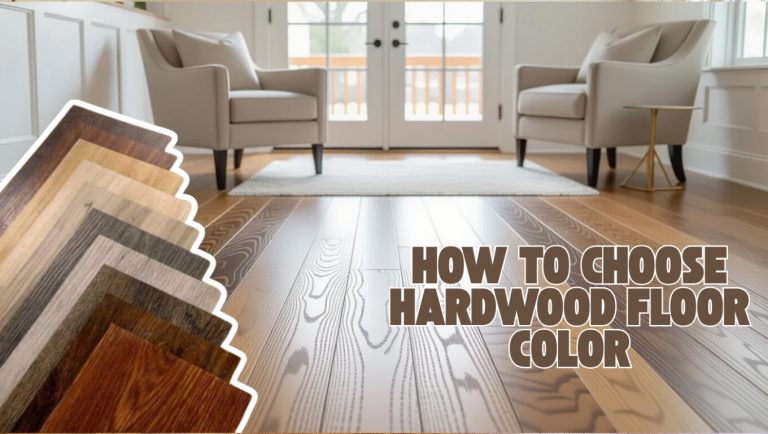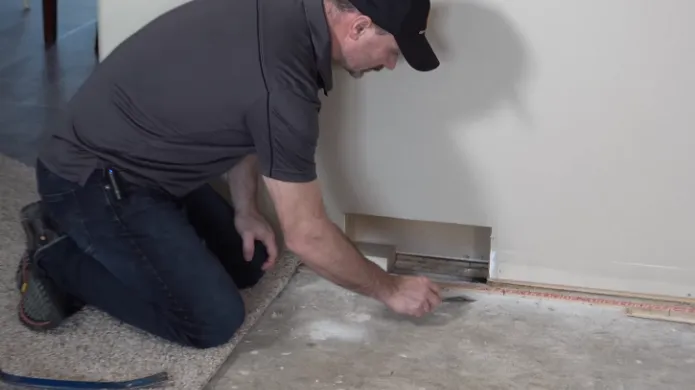Why Is My Engineered Wood Floor Turning Black: 4 Reasons [Covered]
Have you noticed that your once beautiful engineered wood floor is turning black? This can be a bothersome issue, as black stains not only detract from the appearance of your flooring but can also indicate a more serious problem.
One of the primary causes of black stains on engineered wood floors is moisture. This can come from a variety of sources, including spills, leaks, and even humidity in the air.
When moisture is allowed to penetrate the surface of the wood, it can lead to the growth of mold and mildew, which can cause black discoloration.
Other things can turn engineered wood black, too. Understanding these potential causes can help you identify and address the issue at hand. We’ll discuss all the possible reasons why your engineered wood floor is turning black.
Why Is My Engineered Wood Floor Turning Black: Causes and Effects
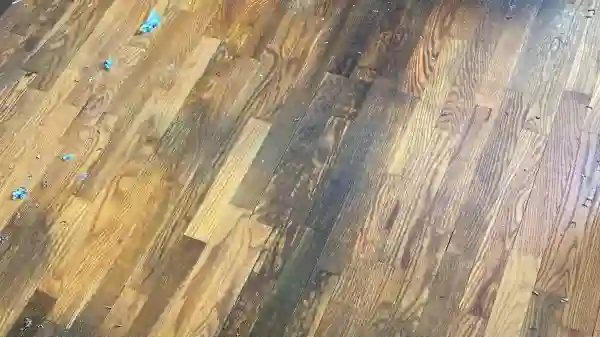
If you’re wondering what’s causing your engineered wood floor to turn black, there are several possible causes to consider. Here’s a quick overview:
- Moisture and Water Damage
- Sap Stains
- Chemical Stains
- Tannic Acid Discoloration
Let’s look at the causes in detail.
1. Moisture and Water Damage
Moisture and water damage can cause black discoloration in your engineered wood floor. When water seeps into the floorboards, it can lead to mold or mildew growth.
These fungi often appear as black patches or stains, which can be unsightly and potentially harmful to your health.
Mold and mildew can release spores that trigger respiratory problems and allergies, making it important to address this issue as soon as possible.
Additionally, moisture can cause the wood to expand and contract, damaging the subfloor and the engineered wood flooring.
This can lead to warping, buckling, and cupping, which can be costly to repair or even require a complete replacement of the affected flooring.
2. Sap Stains
You may have noticed black spots or stains on your engineered wood floor, known as sap stains. These unpleasant discolorations can occur when sap from the underlying layers of the wood rises to the surface and reacts with oxygen.
Sap stains are a common issue that can affect engineered wood floors, especially those made with softer wood species.
They’re not only unsightly, but they can also affect the structural integrity of your flooring if left untreated. When the sap rises to the surface, it can cause the wood fibers to weaken and break down over time.
3. Chemical Stains
If you’re using cleaning products not specifically designed for engineered wood floors, be prepared for a surprising outcome.
Chemical stains are a common problem when certain chemicals or cleaning agents react with the wood’s surface. These reactions can cause the wood to darken or turn black, leaving unsightly stains that can be difficult to remove.
To prevent chemical stains from occurring, it’s important to only use cleaning products that are specifically designed for engineered wood floors. Avoid using harsh chemicals or abrasive cleaners that can damage the surface of the wood.
If spills of corrosive substances occur, be sure to clean them up immediately with a damp cloth and a mild cleaning solution.
4. Tannic Acid Discoloration
Tannic acid is a naturally occurring substance found in various types of wood, including oak, chestnut, and walnut, among others.
When wood containing tannic acid is exposed to moisture or metal, the acid reacts and causes a chemical stain that appears as black discoloration on the floor’s surface.
The discoloration caused by tannic acid can vary in intensity, depending on the type and concentration of the acid in the wood.
The staining can be more pronounced in areas with high moisture levels, such as near windows or doors, or in areas where metal objects are frequently placed, such as furniture legs or appliances.
How Can You Address the Issue of Your Engineered Wood Floor Turning Black?
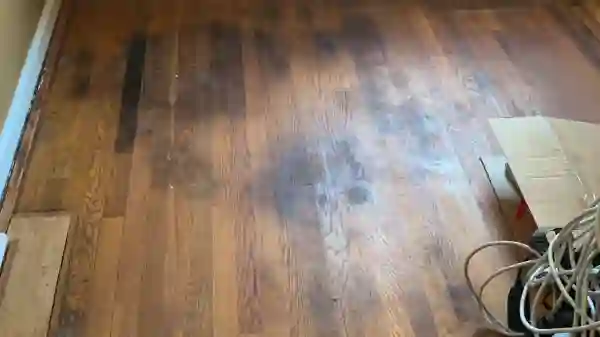
If you’re wondering how to fix your engineered wood floor turning black, there are a few key steps to take.
1. Identify the Cause
To effectively address the discoloration of your engineered wood floor, it’s imperative to identify the underlying cause.
Various factors, such as moisture, mold, chemical stains, or other environmental factors, can cause discoloration. Identifying the cause will help you choose the appropriate course of action to remedy the situation.
One common cause of discoloration on engineered wood floors is moisture. Excess moisture can seep into the wood and cause it to turn black. This is especially prevalent in areas with high humidity levels. Mold can also grow in moist areas, which can cause discoloration on your floors.
It’s important to address moisture issues as soon as possible to prevent further damage to your floors.
2. Clean and Dry the Floor
Ensure you thoroughly clean the affected floor area with a mild cleaner or warm water and vinegar and take extra care to dry it out completely to avoid any further moisture-related issues. You want to ensure the floor is bone dry, like a desert in the middle of summer.
Here are a few tips to help you properly clean and dry your floor:
- Use a mild wood floor cleaner, warm water, and vinegar to remove any dirt or debris from the affected area.
- Ensure to wash your mop or cloth thoroughly before using it on the floor to avoid adding excess moisture.
- Once you’ve cleaned the area, use a dry towel or fan to help speed up the drying process. Avoid using a heating source like a hair dryer, as this can cause the floor to warp or buckle.
3. Sand the Floor
After cleaning, if the discoloration persists, gently sanding the affected area, like polishing a rough gemstone, can restore the wood’s natural color.
Begin by selecting a fine-grit sandpaper, such as 220-grit. It’s important to avoid using coarse-grit sandpaper, as it can cause further damage to the wood.
Attach the sandpaper to a hand-held sanding block or a floor buffer to begin sanding. Move the sandpaper back and forth across the affected area, applying gentle pressure.
Be sure to sand evenly across the entire surface, taking care not to sand too deeply in any one spot.
Once the affected layer has been removed, clean the area with a damp cloth and inspect the surface for any remaining discoloration. If the discoloration persists, repeat the sanding process until the wood’s natural color is restored.
4. Apply a Wood Stain Remover
To remove those unsightly black marks, try applying a wood stain remover according to the product instructions and watch them disappear like a magician’s disappearing act.
First, choose a wood stain remover or bleaching agent that’s safe for use on engineered wood floors. Some products may contain harsh chemicals that could damage the surface of your flooring, so it’s important to read the label carefully.
Once you have the appropriate product, apply it to the affected areas with a clean, soft cloth or sponge. Be sure to follow the manufacturer’s instructions carefully, as some products may require you to let the solution sit for a while before wiping it away.
After applying and wiping away the stain remover, thoroughly rinse the area with clean water and allow it to dry.
5. Refinish the Floor
Now that you’ve applied the wood stain remover and successfully removed the discoloration, it’s time to consider refinishing the entire floor or just the affected area.
Refinishing an engineered wood floor involves sanding the existing finish, applying a new stain or finish, and sealing it with a protective coating. This process not only restores the floor’s appearance but also protects against future issues.
The first step in refinishing your floor is to sand it down to remove the existing finish. This can be done using a floor sander rented from most hardware stores.
Once the sanding is complete, you can apply a new stain or finish to the wood. This will help to enhance the natural beauty of the wood and protect it from damage.
Finally, you’ll need to seal the floor with a protective coating, such as polyurethane. This will provide a durable, long-lasting finish that protects your floor from scratches, stains, and other damage.
6. Preventive Measures
Due to mold and mildew growth, don’t let your beautiful engineered wood flooring turn black. You can easily prevent this issue by following a few simple preventive measures.
Firstly, maintain a consistent humidity level in the room where the flooring is installed. Ideally, the humidity level should be between 30-50%.
Use a hygrometer to monitor the humidity level and a dehumidifier or humidifier to adjust it as needed.
Secondly, promptly clean up any spills or water damage to prevent moisture from seeping into the flooring and causing mold growth.
Use a dry or damp cloth to wipe up the spill and make sure the affected area is completely dry. Additionally, use protective mats or rugs in high-risk areas like entryways, kitchens, and bathrooms.
Regularly inspect the flooring for any moisture or mold growth signs, such as a musty smell or discoloration.
Can you use bleach to remove black stains from the engineered wood floor?
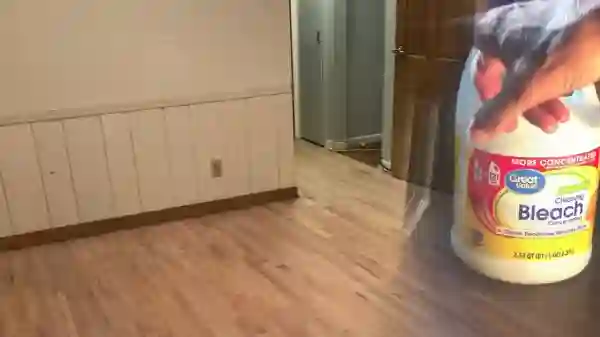
Using bleach can be a workable solution for removing black stains from your engineered wood floors, but be cautious and follow safety guidelines to avoid damaging the wood.
Bleach is a powerful agent that can break down chemical bonds and remove tough stains.
To use bleach, dip a small brush, such as a toothbrush, into a small amount of bleach and gently rub it onto the black stain.
Be sure to wear gloves and protective eyewear to avoid any skin or eye irritation. Alternatively, you can use oxalic acid, another effective disinfectant, to bleach your wood floors.
However, it’s important to use bleach or oxalic acid with caution and follow proper safety precautions and manufacturer’s instructions to avoid any damage to the wood.
Oxalic acid is a highly acidic substance and should be used with care. Always dilute the acid before using and test it on a small, inconspicuous area of the floor before applying it to the stain.
Does baking soda remove black marks from hardwood floors?
You can easily remove black marks from your hardwood floors with baking soda, which acts like a gentle eraser. Mix a small amount of baking soda with water until you have a paste-like consistency.
Apply the paste onto a cloth or toothbrush and gently rub it over the black mark on the hardwood floor. Baking soda is mildly abrasive, which helps to lift and remove the scuff mark without causing any damage to the wood.
Remember to rinse the area with clean water and dry it thoroughly after removing the black mark. Baking soda is a safe and natural cleaning solution that can be used on hardwood floors to tackle various stains and marks.
This method is effective, easy, and inexpensive, making it an excellent choice for removing black marks from your engineered hardwood floor.
Keep Your Engineered Wood Floors Looking Great with Proper Care and Maintenance
Now you know what’s causing your engineered wood floor to turn black and what you can do about it.
Remember, prevention is key, so be sure to keep your floors clean and dry and avoid using harsh chemicals that can damage the wood.
If you do notice black stains, act quickly to remove them using the appropriate cleaning solution, and avoid using bleach, as it can cause damage.
With the popularity of hardwood floors, it’s important to understand how to properly care for them and address any issues that may arise, such as black stains on engineered wood floors. Follow these tips to keep your floors looking great and extend their lifespan.

